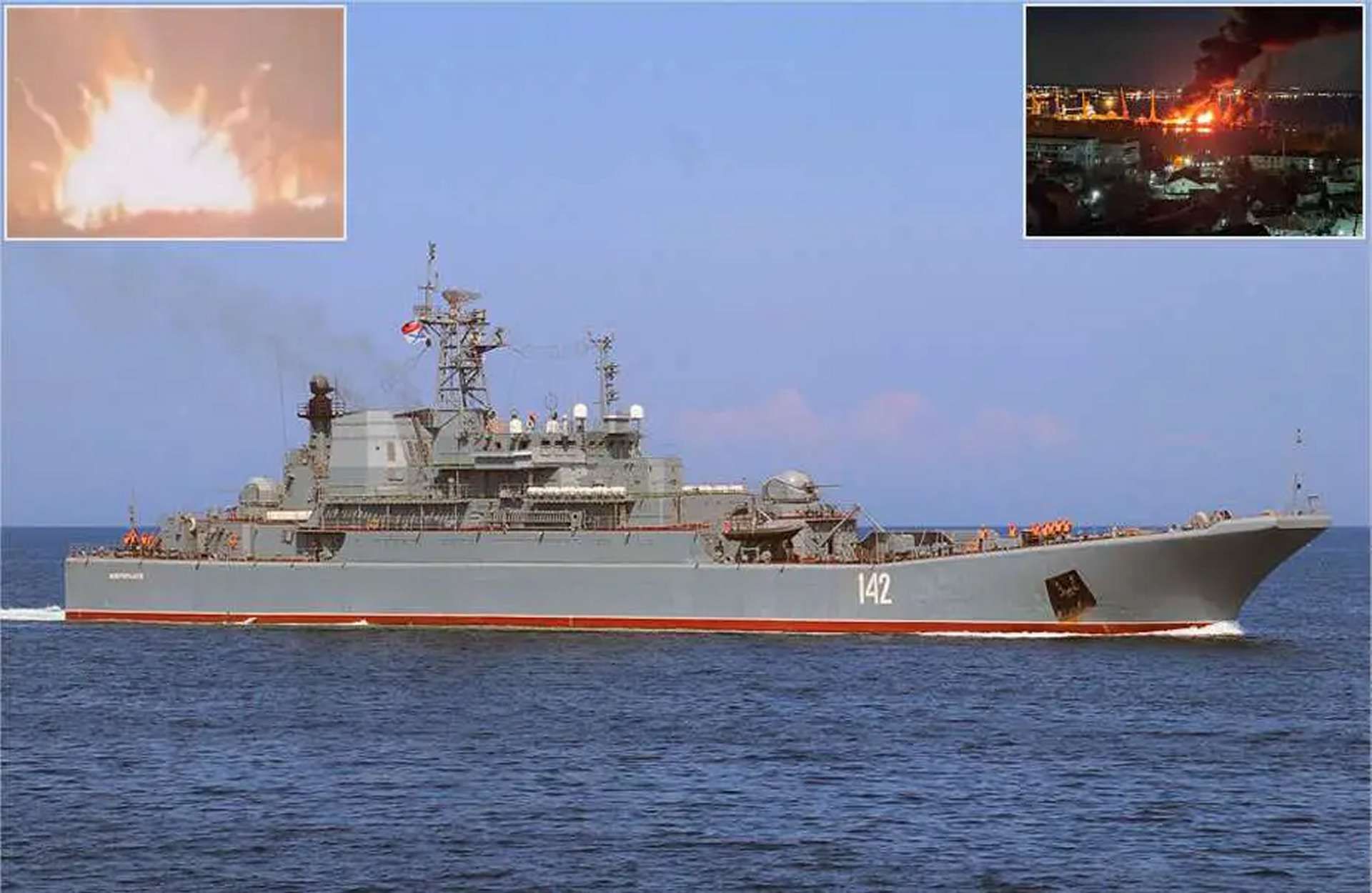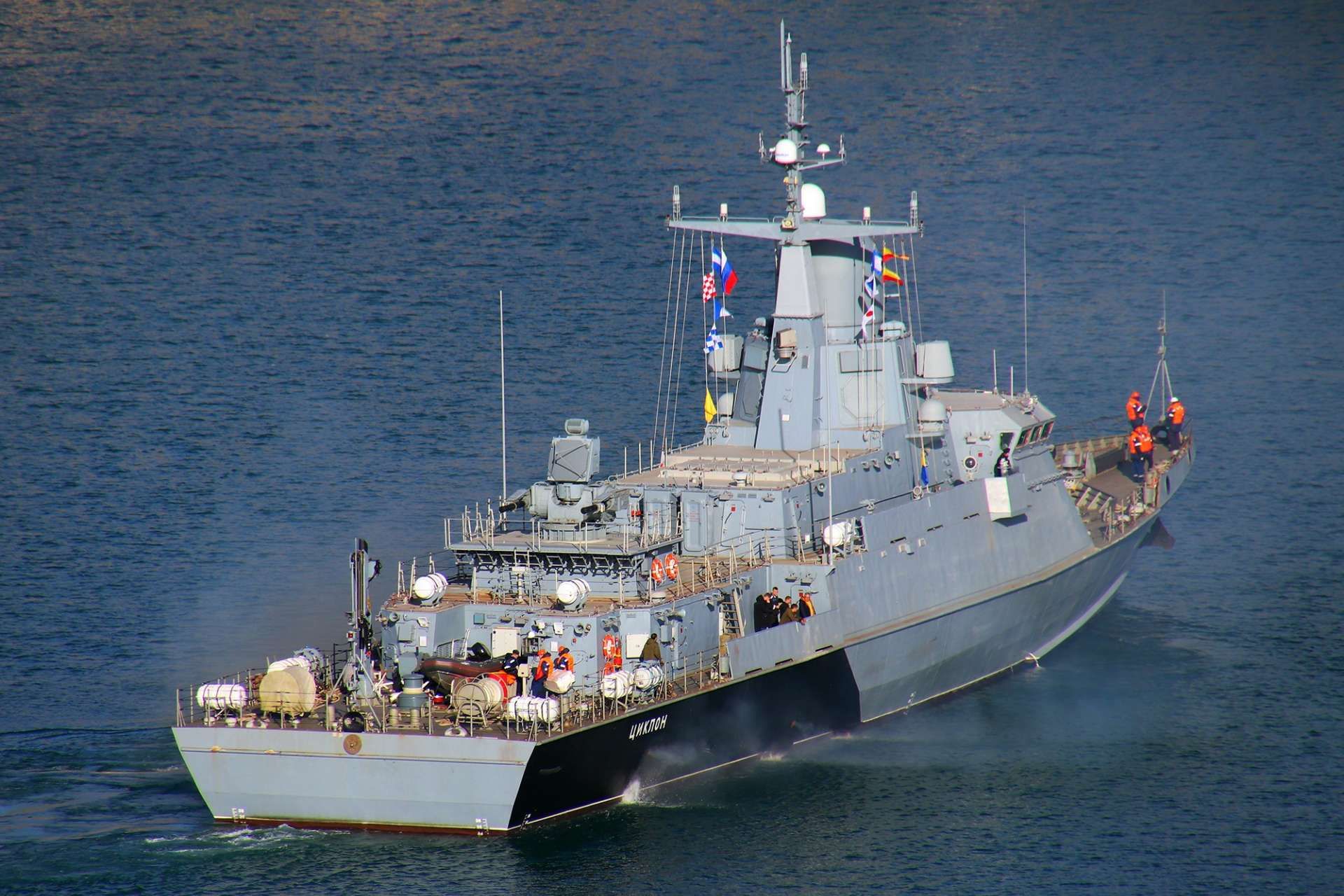Breaking news
Russian sources confirm Tsiklon Karakurt-class missile ship was sunk by US-supplied ATACMS missiles.
On May 19, 2024, Russian military bloggers confirmed that the latest strike conducted by Ukrainian forces led to the sinking of the Project 22800 Karakurt class "Tsiklon" missile corvette in the port of Sevastopol. Ukrainian spokesman Dmytro Pletenchuk stated on television that the attack, which involved two US-provided ATACMS missiles, could signify the loss of the last Russian cruise missile carrier in Crimea.
Follow Army Recognition on Google News at this link

The Tsiklon ("Cyclone") (serial number 801) was laid down at the Zalyv Shipbuilding yard in Kerch on July 26, 2016, entered service with the Russian Black Sea Fleet on July 12, 2023, and commenced combat duty on August 22, 2023. (Picture source: Russian social media)
Initially, Ukrainian channels reported that the minesweeper "Kovrovets," part of the Project 266M Natya class, was the target. However, Russian sources have not confirmed any damage to the Kovrovets at the time of writing. The situation remains unclear, with ongoing uncertainty about which ship(s) were hit in Sevastopol. The Kovrovets, a Project 266M Natya class minesweeper, has been in service since the Soviet era and is equipped to detect and neutralize naval mines.
Ukraine has sunk or significantly damaged several Russian ships in the Black Sea Fleet, demonstrating notable effectiveness despite having a much smaller navy. The most notable of these incidents was the sinking of the Moskva, the flagship of the Russian Black Sea Fleet, on April 14, 2022. The guided-missile cruiser was hit by Ukrainian Neptune anti-ship missiles, resulting in its sinking and marking a significant blow to Russian naval capabilities.
On March 24, 2022, the Alligator-class landing ship Saratov was destroyed while docked in the port of Berdyansk. This attack also caused damage to the landing ships Tsesar Kunikov and Novocherkassk, although they managed to escape with minimal damage at the time. However, the Tsesar Kunikov was later critically damaged and sunk by a Ukrainian naval drone attack near Alupka in February 2024. The Novocherkassk, which had initially survived, was struck again and reportedly sunk in December 2023 while berthed in the port of Feodosia, likely by Storm Shadow or SCALP missiles.
Another significant loss for the Russian fleet was the Kilo-class submarine Rostov-on-Don, which was heavily damaged during a Ukrainian missile strike on a dry dock in Sevastopol on September 13, 2023. This same attack also seriously damaged the Ropucha-class landing ship Minsk. The Olenegorsky Gornyak, another landing ship on loan from the Northern Fleet, was severely damaged by a Ukrainian unmanned maritime drone in Novorossiisk on August 4, 2023. Additionally, the guided missile corvette Ivanovets was attacked and damaged by Ukrainian forces on February 1, 2024.
Patrol ships have also been targeted, with the Sergey Kotov reportedly sunk by Ukrainian sea drones in early 2024. Furthermore, reports indicate that other smaller vessels, including patrol boats, have been destroyed or damaged by Ukrainian sea drones and missile strikes throughout the conflict. These strategic attacks by Ukraine have reduced the operational capabilities of the Russian Black Sea Fleet and have forced Russia to pull back many of its surface vessels to avoid further losses.

One of the latest Russian Black Sea Fleet ships sunk by Ukraine in December 2023, the Novocherkassk, a Ropucha-class landing ship, had the ability to carry an impressive cargo load of up to 500 tons. (Picture source: Russian social media and Twitter)
The Tsiklon ("Cyclone") (serial number 801) was laid down at the Zalyv Shipbuilding yard in Kerch on July 26, 2016, entered service with the Russian Black Sea Fleet on July 12, 2023, and commenced combat duty on August 22, 2023. This Karakurst-class vessel was part of the 41st Sevastopol Order of Nakhimov Brigade of Missile Ships and Boats, a naval formation within the Russian Black Sea Fleet and designated the best brigade in the Russian Navy in 2008. Established on August 20, 1919, the brigade has evolved from torpedo boats to missile boats. Key historical events include participation in Operation Anadyr during the Cuban Missile Crisis and combat roles during the War in Georgia (2008) and the Russian invasion of Ukraine in 2022. As of 2024, the brigade's fleet comprises various classes of missile boats and small missile ships, such as Project 1239, Project 1241, and Project 21631 vessels.
The Project 22800 Karakurt class is a series of Russian small missile corvettes that have been entering service with the Russian Navy since 2018. Designed by the Almaz Central Marine Design Bureau, these ships are intended to provide a more seaworthy, blue-water complement to the Project 21631 Buyan-M-class corvettes, which are optimized for shallow waters like the Caspian Sea and large rivers. The Karakurt class, while facing some construction delays due to engine supply issues and international sanctions, continues to represent a significant asset in the Russian Navy, serving as a response to the operational limitations observed in the Buyan-M class in open seas.
Intended for operations in the near sea zone, the Karakurt class boats have notable capabilities for their size, with a full displacement of 870 tons, a length of 67 meters, and a beam of 11 meters. Propulsion is provided by three Zvezda M-507D1 diesel engines and three DGA-315-1 diesel generators, allowing for speeds of up to 30 knots and a cruising range of 2,500 miles at 12 knots. The ships are equipped with a variety of sensors and processing systems, including the Mineral-M radar, Pozitiv-M 1.2 3D radar, and AESA-type radar, providing robust situational awareness and targeting capabilities.
Serving as a replacement for the larger and more costly Project 11356R Burevestnik frigates, which faced production delays due to halted engine supplies from Ukraine, the Karakurt class is armed with a mix of offensive and defensive systems. Primary armament includes eight UKSK vertical launch system (VLS) cells capable of launching Kalibr or Oniks missiles. The corvettes also feature a 76.2 mm AK-176MA automatic dual-purpose gun, although the first ship (the "Mytishchi", ex-"Uragan") was armed with a 100 mm A-190 gun. For close-in defense, the first two vessels are equipped with AK-630M gun-based close-in weapon systems (CIWS), while starting from the third ship, the Pantsir-M air defense system has been installed, providing enhanced air defense capabilities.
The construction of these ships is a collaborative effort among multiple Russian shipyards, including Pella, More, Zelenodolsk, and Zaliv, and as of May 2024, a total of 14 Karakurt-class ships have been built, with four currently in service, two under construction, and two canceled. The class is planned to eventually comprise 18 ships. The first two ships were laid down in December 2015, with subsequent ships being constructed at various shipyards across Russia. The lead ship, originally named Uragan (now Mytishchi), was delivered to the fleet in December 2017, followed by others such as Sovetsk, Kozelsk, and Odintsovo.

The Karakurt class is armed with a mix of offensive and defensive systems, including Kalibr or Oniks missiles, a 76.2 mm AK-176MA automatic dual-purpose gun, and an AK-630M gun-based close-in weapon system (CIWS) or Pantsir-M air defense system. (Picture source: Russian social media)


























